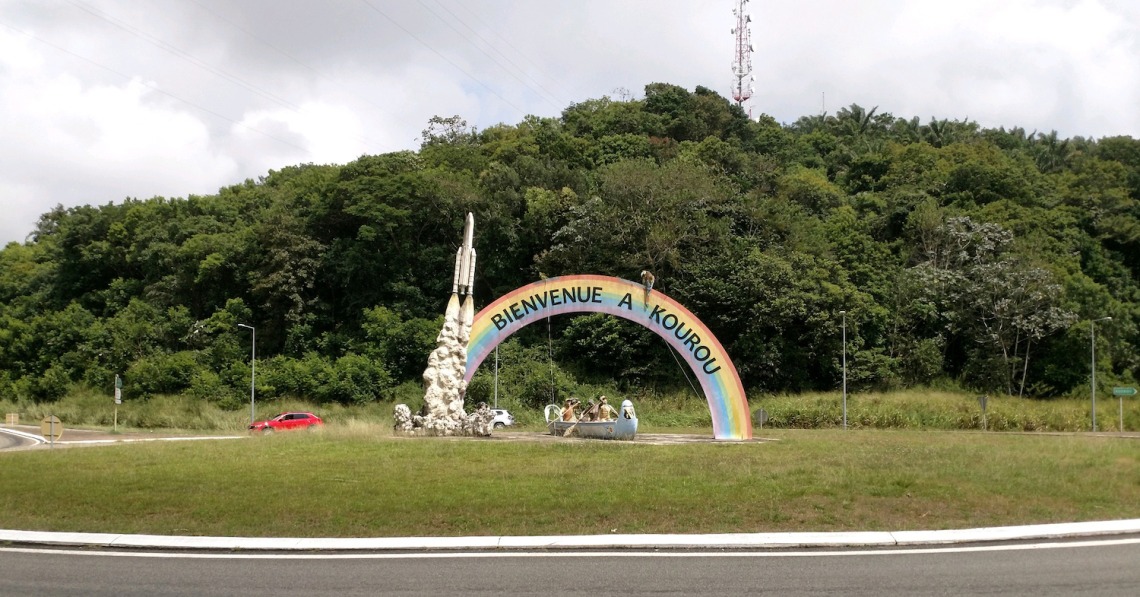Field Notes: Testing NIRcam in the middle of a jungle

A monument welcomes visitors to the town of Kourou.

A life-size replica of the Ariane 5 rocket stands in front of the Centre Spatial Guyanais (Guiana Space Center) in Kourou.

Doug Kelly, systems engineer in Steward Observatory
Field Notes is an occasional series in which faculty and staff members share experiences from their field research. In this Field Notes column, Doug Kelly, a systems engineer in Steward Observatory, writes about a trip he took to French Guiana this fall as part of preparations for the launch of the James Webb Space Telescope, which could happen as soon as Dec. 24.
I recently returned from French Guiana, where I worked with Dan Lewis of Lockheed Martin to perform a functional check of the Near Infrared Camera, which will be aboard the James Webb Space Telescope when it launches.
NIRCam – which was developed through a partnership between the University of Arizona and Lockheed Martin's Advanced Technology Center – will image the first galaxies to form in the universe, study the evolution of galaxies and probe star formation regions to understand the birth and early evolution of stars and planetary systems.
It took about six months to prepare for the trip, including numerous visits to the University's excellent immunization and travel clinic. NASA chartered a flight to bring the team of spacecraft, telescope and instrument experts down to French Guiana safely.
During my visit, I was able to spend some time exploring the town of Kourou and the surrounding jungle. The undergrowth was quite thick so off-road travel was not very feasible. I found a nice trail between my hotel and the space base and walked it daily. I saw a toucan and a sloth, monkeys and iguanas, and a dachshund-size, squirrel-like rodent called a red-rumped agouti.
Much of the local economy seems to be associated with growing bananas, and I had fresh bananas, papayas and pineapple every day. I visited during the dry season and saw only two short rainfalls in 10 days. It rains for days on end at other times of the year.
Another highlight of the trip was seeing an Ariane 5 rocket launch. I watched the nighttime launch from town. In spite of thick clouds, the flames from the rocket lit up half the sky, and the rocket made a loud roar as it streaked overhead.
The next launch will be ours.
NIRCam's journey
I joined the NIRCam team as a systems engineer in 2003. The development and testing phase took 10 years, culminating in delivery of the fully qualified camera to the Goddard Space Flight Center at the start of 2014.
NIRCam serves both as a science camera for Webb and as the camera that will be used to align the 18 mirror segments – which are 1 meter in diameter – so that they work together as a single 6.5-meter telescope dish.
In late September, Webb was loaded in its shipping container and driven down Interstate 405 to a waiting ship in Long Beach, California. It then traveled 5,800 miles down the Baja coast, went through the Panama Canal and arrived in French Guiana, on the northeast coast of South America. French Guiana was chosen as the location for the European Space Agency spaceport because it is near the equator, resulting in maximum lift due to the rotation of the Earth, and because it has open ocean to the east so that rockets are not over land in the event of an abort. At the completion of this Webb shipment, we needed to perform another functional test – this being the last one prior to launch.
The tests are cool – or warm
We run NIRCam functional tests every time the observatory is moved, after we subject the observatory to the vibrations and pressure oscillations associated with launch and any time power or communication cables affecting NIRCam are disconnected and reconnected.
NIRCam needs to be cooled to its flight temperature of minus 387.4 degrees Fahrenheit for a full checkout of its performance. This has only been done three times since instrument delivery – twice at Goddard after the four science instruments were installed in the Webb instrument compartment and a final time at the Johnson Space Center in 2017 after the instrument compartment was connected to the telescope. All other post-delivery tests have been warm functional tests.
The functional testing involves powering up the electronics, moving all the mechanisms and taking a few pictures. This is comparable to the checkout you could do of your digital camera if you were unable to remove the lens cap. You could turn on power, check all the indicator lights, test the flash, move the focus, take pictures and make sure they have the right format, but you could not confirm that the camera is working properly as a system.
While this was our 25th instrument-level test of NIRCam, it was the first conducted in a developing country in the middle of the jungle. The team consisted almost exclusively of people who have been on the project for at least 10 years, and all the teams exhibited great care to make sure that Webb was fully ready for launch.
It was easily the smoothest test we have run yet, and all systems checked out.
If you have an idea for a Field Notes column, send an email to Andy Ober at andyober@arizona.edu.

